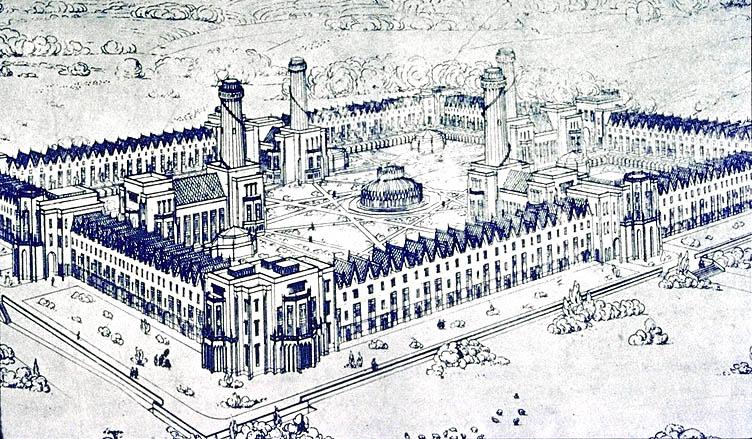
We are celebrating 15 years — and counting — of stories that are deeply researched and deeply felt, that build a historical record of what the city has been.
We are celebrating 15 years — and counting — of stories that are deeply researched and deeply felt, that build a historical record of what the city has been.
Disaster is an opportunity — with the need to escape comes a potential fresh start. In the 17th century, the utopian dreamers fleeing religious persecution in England were handed a singular chance. Puritans erecting meeting houses in New Haven and Quakers breaking ground in Philadelphia could put into practice a long history of ideas about the composition of a perfect city. Though other thinkers had attempted to enact elements of Biblical geometry and Thomas More’s utopian program before, they mostly worked in the realm of speculative manuscripts and plans. But on the apparently blank canvas of the American landscape, as Michael J. Lewis reveals in City of Refuge: Separatists and Utopian Town Planning, European settlers built communities according to the architectural and moral principles that had until then remained strictly aspirational. They ignited a tradition of refuge in the New World that would appeal to later waves of Christian Separatists, like the German Harmonists, and socialist utopians like Robert Owen. However worldly his concerns, Owen nevertheless perceived a moral crisis in European society, and saw in the Indiana soil a chance to start anew.
Today’s most pressing crises are neither spiritual, nor metaphysical, but environmental. For some, citymaking again would provide an answer to disasters — and disasters could provide an unprecedented opportunity for citymaking. In the introduction to 2100: A Dystopian Utopia, sociologist Saskia Sassen demands we “delegate back to the biosphere”: lean into the vagaries of climate change and put seemingly adverse environmental circumstances to work sustaining human existence. Architect Vanessa Keith answers the call, drawing on existing climate change projections to imagine the habitable world 100 years hence, when desertification and rising sea levels push human society to the margins of the present geography of settlement. Keith proposes a masterplan for 14 global “extraction cities” and “compact megacities” that work with the changing environment, not against it. The challenges are considerable: in 2100, 40 percent of the world’s current agriculture will be untenable, and a 6.5 feet rise in sea level will force the migration of more than 600 million people. But necessity is the mother of invention, and against the post-apocalyptic backdrop, Keith’s global program proposes an orderly, adaptive urban vision, often through “clip-on” additions to the existing fabric. From Manila to Moscow, surging waves and wind storms are harnessed for energy, old cities are submerged while new structures perch atop elevated plinths, and miners extract Antarctic snowmelt to provide water to the rest of the world.
In New York 2140, disaster has already struck. Two successive sea level rises have left New York City a warren of canals, which a motley crew of survivors and thrivers navigate on speedboats and high-tech surfboards. Citizens wander skybridges overhead. Condemned brownstones and small apartment buildings collapse into the precarious intertidal zone in Chelsea, as the upper-middle-class colonize the old Met Life Building, and wealthy financiers trade in “coastal futures,” betting on the weather. But where Keith’s renderings are populated with amiable scalies living and working in apparent harmony, speculative novelist Kim Stanley Robinson’s world emanates more recognizably from our own. Government’s dependence on “public-private partnerships” to fund infrastructure and services for climate refugees is all-too-familiar; the characters’ ability to carry on their lives, obsessed with gadgets and gossip, in the face of destruction is both human and frightening. By the book’s climax, it’s evident that the preceding disasters were not enough to wake these citizens to the necessity of global re-invention; or that by the time they awoke, it was too late to do much more than muddle and patch.
Meanwhile, Keith Krumwiede has little patience for heady dreams of hyperdense future cities of spindly walkways and modular pods. To Krumwiede, architects’ obsession with urbanism, traditionally defined, smacks of elitism and nostalgia for pre-war city living. To fashion a more hopeful future, he argues, architects ought to use the materials broadly at hand: the mass-designed, mass-produced, mass-marketed McMansions of the much-disdained suburban subdivision. In Atlas of Another America, utopian planning conforms to historically American, capitalist ideals — space, autonomy, private property, self-sufficiency — but mimics the more ancient history of ideal town geometries in pursuit of new sustainability. The result, “Freedomland,” is cut free of time and space: undifferentiated, flat, green squares of land are gridded into 128 agricultural estates, self-sustaining and containing between eight and 64 houses. The houses themselves are sprawling, personalized palaces, composited from recognizable plans by contemporary mass housers. The design and function of the various sections rotate around the estates over time, like a three-field crop system, so homeowners can continually reinvent their homes from component parts. This satisfies what Krumwiede sees as basic human desires for newness and choice, and forestalls the bursting market bubbles now commonly associated with these architectural types. The Atlas certainly has a satirical bite, but it also issues a fervent message, which Robinson echoes. In the midst of a crisis, it’s perfectly possible to imagine ideally designed futures. But getting society to collectively course-correct might be more implausible than science fiction. For a real city, there’s no such thing as a fresh start.
The views expressed here are those of the authors only and do not reflect the position of The Architectural League of New York.
